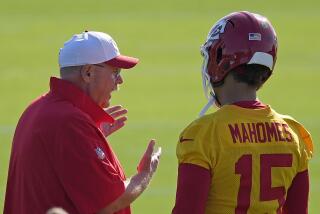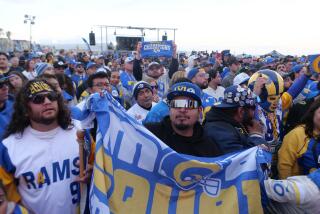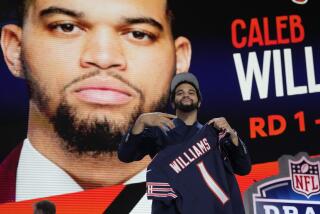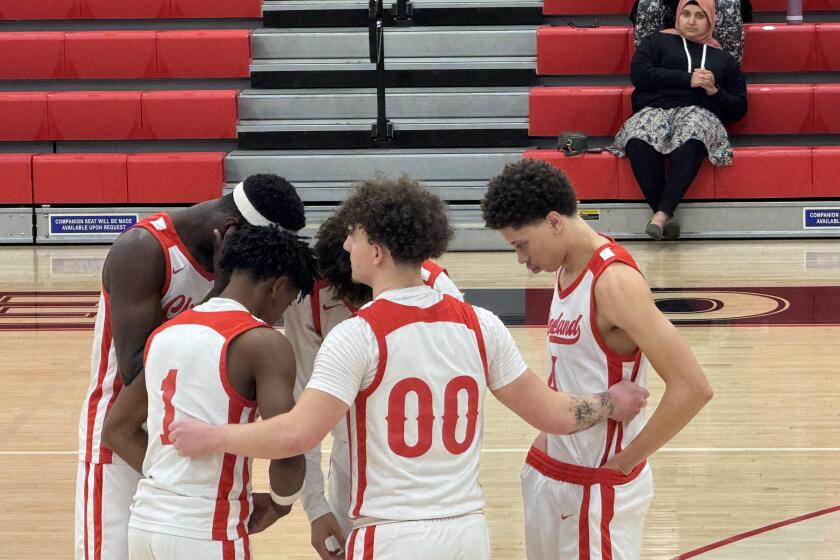QB, OR NOT QB
- Share via
There’s nothing like a No. 1 draft pick to generate excitement around a downtrodden NFL team, generating visions of Terry Bradshaw hoisting the Lombardi Trophy or Peyton Manning leading his team to a Super Bowl title.
But if history is any guide, that pick is just as, if not more likely, to end up in a bust such as Jeff George or Tim Couch. Of the 15 quarterbacks taken with the No. 1 pick since 1970, only three have won the Super Bowl with the team that drafted them, while eight never made it to the playoffs with their original team.
“There’s about a 50-50 hit versus bust ratio,” said Mike Mayock, a draft analyst for the NFL Network. “It is the most difficult and complicated evaluation of any position. It’s not just about arm strength. If it was about arm strength, Ryan Leaf and Jeff George would have been All-Pros. But so much more goes into the quarterback position. The two biggest criteria are understanding the game, knowing when and where to throw the ball, and work ethic, which ties into leadership.”
In a league that tries to put a numerical value on qualities ranging from speed to strength to intelligence, there’s no foolproof test to determine which quarterbacks will succeed.
That’s the situation facing the Oakland Raiders as they contemplate whether to use the No. 1 pick later this month on a quarterback such as JaMarcus Russell of LSU or Brady Quinn of Notre Dame.
Russell has the physical tools that make scouts drool, a 6-foot-6, 263-pound frame, the ability to throw a perfect strike 80 yards downfield and the mobility expected of the modern quarterback. Quinn has four years of experience in the high-pressure environment at Notre Dame, two years of tutelage from NFL guru Charlie Weis and solid skills.
This is just the latest quarterback debate at the top of the draft, following Drew Bledsoe and Rick Mirer in 1993, Manning and Leaf in ‘98, or Couch and Donovan McNabb the following year.
“This is the classic dilemma right here,” Mayock said. “Quinn has a higher floor. You know what you’re getting with him. ... Russell has the most imposing physical skill set of any quarterback I’ve seen since John Elway. If he ever turns into what he could be, you’ll be looking at a perennial All-Pro quarterback who can be as good as he wants to be. The problem is work ethic issues, and there’s not as much tape and you don’t know how much he loves the game. He has the higher ceiling, but Quinn has the higher floor.”
Since Bradshaw won his fourth Super Bowl title with the Pittsburgh Steelers in January 1980, more than half of the NFL championships -- 14 of 27 -- have been won by quarterbacks taken after the first round. And six of the first-round winners did it with a team other than the one that drafted him.
While few teams in need of a quarterback are willing to pass on the potential franchise passer, going that route can be beneficial. The San Diego Chargers had the top pick in 2001 when Michael Vick came out billed as a player who would change the position.
The Chargers traded the pick to Atlanta and selected record-setting running back LaDainian Tomlinson four picks later and added a quarterback in the second round -- Drew Brees -- who has had more success than Vick in the NFL. Three years later, San Diego again had the No. 1 pick in a year when most analysts agreed Eli Manning was a can’t-miss quarterback.
But with Eli Manning unwilling to play in San Diego, the Chargers traded him to New York for a package that turned into three Pro Bowl players: quarterback Philip Rivers, linebacker Shawne Merriman and kicker Nate Kaeding.
The Raiders could decide to pick receiver Calvin Johnson out of Georgia Tech or trade down to get multiple picks, but appear headed to take a quarterback after passing on Matt Leinart and Jay Cutler in the first round last year.
“It all depends on how you feel about Andrew Walter,” draft analyst Gil Brandt said. “I thought Andrew Walter was a real steal when they got him in the third round in 2005. If they think he can still be a pretty good football player, they might take a quarterback.”
Brandt has been following the draft for nearly a half-century, first as the personnel director for the Dallas Cowboys and now as the NFL’s draft adviser. He believes many of the quarterback busts have been players who had little college experience, unlike Quinn and Russell.
But there are hurdles other than lack of experience that quarterbacks can face making the transition to the NFL.
“What happens is that usually a quarterback gets picked first and goes to a bad team,” Brandt said. “When you factor in going to a bad team and the jump you have to make from college, the job is almost unbelievable. Playing the position is hard enough. Going to a team that’s not very good makes it that much harder.”
And few teams have been as bad on offense as the Raiders were last year, when they scored only 168 points -- fifth fewest in a 16-game season -- had 12 offensive touchdowns and allowed a league-worst 72 sacks. The problems were so deep that they can’t expect to be solved just by better play at quarterback, especially from a rookie.
Like most top picks, Russell and Quinn played on top college teams that usually had more talent all over the offense than the opposition. That won’t be the case on the Raiders, a team running low on patience after going just 15-49 since winning the 2002 AFC championship.
“We’re at a point right now where it’s been four straight losing seasons and everybody wants to win right now,” Raiders cornerback Nnamdi Asomugha said. “There’s definitely going to be high expectations. Will they be too high? No, because we’ll be realistic and know this is a rookie even though he’s the first pick. But you definitely have high expectations for the No. 1 overall pick of the draft. There’s no way to get around that.”
Raiders coach Lane Kiffin tutored many players in college at Southern California who went on to become high draft picks in recent years in the NFL, including quarterbacks Carson Palmer and Leinart. Kiffin said the transition is even harder for quarterbacks, who often face higher expectations and don’t have the luxury of easing into a playing role.
“It’s hard on them when they’ve come from a program where they don’t know anything but winning, national championships, Heisman Trophys and now all of a sudden, they’re one of the guys, sitting on the bench,” Kiffin said. “You’ve got to get to know them, especially your rookies, because it’s going to be real hard on them. It’s a long season, it’s a grind on them, and you’ve got to stay in touch with them and not leave them on their own.”
*
(BEGIN TEXT OF INFOBOX)
Head of the class
Quarterbacks taken No. 1 overall in the draft since 1970:
1970 -- Terry Bradshaw Pittsburgh
1971 -- Jim Plunkett New England
1975 -- Steve Bartkowski Atlanta
1983 -- John Elway Baltimore
1987 -- Vinny Testaverde Tampa Bay
1989 -- Troy Aikman Dallas
1990 -- Jeff George Indianapolis
1993 -- Drew Bledsoe New England
1998 -- Peyton Manning Indianapolis
1999 -- Tim Couch Cleveland
2001 -- Michael Vick Atlanta
2002 -- David Carr Houston
2003 -- Carson Palmer Cincinnati
2004 -- Eli Manning San Diego
2005 -- Alex Smith San Francisco
--
Source: NFL.com
Los Angeles Times
--
NFL draft
A look at the order for the first round of the NFL draft:
1. Oakland
2. Detroit
3. Cleveland
4. Tampa Bay
5. Arizona
6. Washington
7. Minnesota
8. Atlanta (from Houston)
9. Miami
10. Houston (from Atlanta)
11. San Francisco
12. Buffalo
13. St. Louis
14. Carolina
15. Pittsburgh
16. Green Bay
17. Jacksonville
18. Cincinnati
19. Tennessee
20. NY Giants
21. Denver
22. Dallas
23. Kansas City
24. New England (from Seattle)
25. NY Jets
26. Philadelphia
27. New Orleans
28. New England
29. Baltimore
30. San Diego
31. Chicago
32. Indianapolis
More to Read
Go beyond the scoreboard
Get the latest on L.A.'s teams in the daily Sports Report newsletter.
You may occasionally receive promotional content from the Los Angeles Times.










